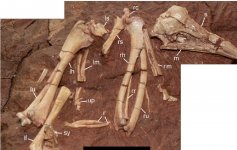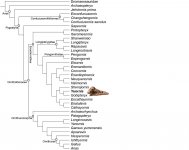Fred Ruhe
Well-known member

Li Xu, Eric Buffetaut, Jingmai O'Connor, Xingliao Zhang, Songhai Jiam Jiming Zhang, Huali Chang & Haiyan Tong, 2021
A new, remarkably preserved, enantiornithine bird from the Upper Cretaceous Qiupa Formation of Henan (central China) and convergent evolution between enantiornithines and modern birds
Geological Magazine. in press.
doi:10.1017/S0016756821000807
Abstract: A new, remarkably preserved, enantiornithine bird from the Upper Cretaceous Qiupa Formation of Henan (central China) and convergent evolution between enantiornithines and modern birds | Geological Magazine | Cambridge Core
A new enantiornithine bird is described on the basis of a well preserved partial skeleton from the Upper Cretaceous Qiupa Formation of Henan Province (central China). It provides new evidence about the osteology of Late Cretaceous enantiornithines, which are mainly known from isolated bones; in contrast, Early Cretaceous forms are often represented by complete skeletons. While the postcranial skeleton shows the usual distinctive characters of enantiornithines, the skull displays several features, including confluence of the antorbital fenestra and the orbit and loss of the postorbital, evolved convergently with modern birds. Although some enantiornithines retained primitive cranial morphologies into the latest Cretaceous Period, at least one lineage evolved cranial modifications that parallel those in modern birds.
The paper describes Yuornis junchangi gen. et sp. nov.
Enjoy,
Fred
A new, remarkably preserved, enantiornithine bird from the Upper Cretaceous Qiupa Formation of Henan (central China) and convergent evolution between enantiornithines and modern birds
Geological Magazine. in press.
doi:10.1017/S0016756821000807
Abstract: A new, remarkably preserved, enantiornithine bird from the Upper Cretaceous Qiupa Formation of Henan (central China) and convergent evolution between enantiornithines and modern birds | Geological Magazine | Cambridge Core
A new enantiornithine bird is described on the basis of a well preserved partial skeleton from the Upper Cretaceous Qiupa Formation of Henan Province (central China). It provides new evidence about the osteology of Late Cretaceous enantiornithines, which are mainly known from isolated bones; in contrast, Early Cretaceous forms are often represented by complete skeletons. While the postcranial skeleton shows the usual distinctive characters of enantiornithines, the skull displays several features, including confluence of the antorbital fenestra and the orbit and loss of the postorbital, evolved convergently with modern birds. Although some enantiornithines retained primitive cranial morphologies into the latest Cretaceous Period, at least one lineage evolved cranial modifications that parallel those in modern birds.
The paper describes Yuornis junchangi gen. et sp. nov.
Enjoy,
Fred





